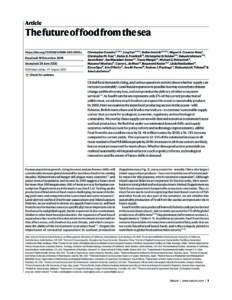The Future of Food from the Sea (2020)

Author:
Christopher Costello, Ling Cao, Stefan Gelcich, Miguel Á. Cisneros-Mata, Christopher M. Free, Halley E. Froehlich, Christopher D. Golden, Gakushi Ishimura, Jason Maier, Ilan Macadam-Somer, Tracey Mangin, Michael C. Melnychuk, Masanori Miyahara, Carryn L. de Moor, Rosamond Naylor, Linda Nøstbakken, Elena Ojea, Erin O’Reilly, Ana M. Parma, Andrew J. Plantinga, Shakuntala H. Thilsted, and Jane Lubchenco
Publication Year:
2020
Citation:
Costello, Christopher, Ling Cao, Stefan Gelcich, Miguel Á. Cisneros-Mata, Christopher M. Free, Halley E. Froehlich, Christopher D. Golden, et al. “The Future of Food from the Sea.” Nature, August 19, 2020. https://doi.org/10.1038/s41586-020-2616-y.
Description:
Global food demand is rising, and serious questions remain about whether supply can increase sustainably. Land-based expansion is possible but may exacerbate climate change and biodiversity loss, and compromise the delivery of other ecosystem services. As food from the sea represents only 17% of the current production of edible meat, we ask how much food we can expect the ocean to sustainably produce by 2050. Here we examine the main food-producing sectors in the ocean—wild !sheries, !n!sh mariculture and bivalve mariculture—to estimate ‘sustainable supply curves’ that account for ecological, economic, regulatory and technological constraints. We overlay these supply curves with demand scenarios to estimate future seafood production. We !nd that under our estimated demand shifts and supply scenarios (which account for policy reform and technology improvements), edible food from the sea could increase by 21–44"million tonnes by 2050, a 36–74% increase compared to current yields. This represents 12–25% of the estimated increase in all meat needed to feed 9.8"billion people by 2050. Increases in all three sectors are likely, but are most pronounced for mariculture. Whether these production potentials are realized sustainably"will depend on factors such as policy reforms, technological innovation and the extent of future shifts in demand.
See related content:
- Explore the site by related topics: Food Security, Marine Fisheries
